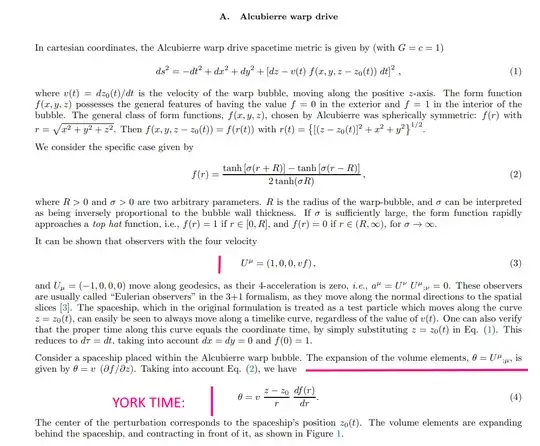What is the exact mechanism of the warp drive that propels it forward? I know that it creates negative pressure behind it and a positive pressure in front of it but how does this actually propels it forward.
3 Answers
There isn't any time-evolution dynamics for warp bubbles that would single out straight-line motion. In fact, there can't be a cause-and-effect relationship between the position of the bubble at different times because it would violate light-cone causality. For the same reason, you can't create or control the bubble locally, so it isn't really a "drive". If this method of travel is possible at all (a very big if), you would have to set up the conditions for the bubble across the whole route in advance, at slower-than-light speed. The bubble would then follow the shape of the track you'd laid down, presumably, but no one has come up with a detailed proposal for how that would work.
- 29,129
The movement is not coming from the pressure, indeed there are contractionless warp drives too which are still able to move.
For superluminal drives, you are forced to create the necessary energy density distribution in advance, so that at the right time the warp can be propelled along the trajectory you designed superluminally, but without requiring tachionic matter. The warp is by definition the metric generated by that energy distribution. By varying the energy profile you can in principle obtain an arbitrary acceleration profile. See for instance chapter 3.2 of this paper.
- 5,191
Good question. The research is at the point where there is a serious debate about what drives the warp drive bubble. The question can be divided into two parts:
- What is the mechanism that maintains the FTL speed once the warp drive bubble has reached it?
- What would cause it to reach a speed greater than c and how? Is there some extra acceleration mechanism needed?
At the heart of the warp drive debate: what is the physical process that causes the warp drive bubble to move? And what would make it reach FTL speed? As I see it, there are two positions/hypotheses:
A): the original Alcubierre one, which says that the expansion/contraction of spacetime is the causal effect. The direction of travel is that space contracts in front of the bubble, expands behind it. In effect, the mechanism causing the expansion of the Universe "works" locally and in a narrow direction. Just as the c-barrier does not apply to the expansion of the Universe, it does not apply to this. There is no detailed, computational model of how the bubble would reach FTL speed. But this idea does not require it to happen by some conventional spacecraft propulsion, but somehow by expansion/contraction. (Alcubierre paper: https://arxiv.org/abs/gr-qc/0009013), (Alcubierre, Lobo paper https://arxiv.org/abs/2103.05610), (Lobo, Visser paper: https://arxiv.org/abs/gr-qc/0406083)
B) The other one, which has become more common in recent years, is that it is not caused by the expansion/contraction of spacetime, it is just incidentally related to it in some models. There are warp spacetimes with no expansion and contraction. According to this there is no real physical process behind it all, so the expansion of the universe is not a good analogy. So warp drive is, for now, just a form of motion defined on paper that fits within the rules of general relativity. Some unknown and as yet unimaginable engine should provide the FTL speed of the bubble. According to this, the position of the warp drive would in fact be the same, not more realistic, than that of the imaginary tachyons (Bobrick,Martire paper: https://arxiv.org/abs/2102.06824)
To our knowledge, neither hypothesis A) nor B) are proven or disproven, but are competing alternatives. An important question that arises here is: if a new warp drive model is discovered, such as Lentz, which version does it fit? Can we place it among those in which expansion and contraction can be detected, and thus establish that such a realistic effect can generate FTL motion? Or, on the contrary, is it rather a counterexample?
However, the proponents of version B) claim not only that they have developed a new hypothesis, but also that version A) is a fallacy that they have disproved, and version B) has been proven. This is the point of the Bobrick-Martire study, among many other developments.
But it is not clear where this follows from, where would it be proven to be so? The Alcubierre-warp-drive papers clearly attribute it to the expansion/contraction effect, also to the equivalent spacetime (van den Broeck spacetime etc.) But the main claim of the Bobrick's is that "warp drives move because they already move, or else they need to propel, and their movement is not related to spacetime expansion or contraction". And so you would need some unknown, ordinary drive in addition, which could accelerate the bubble above c. Therefore, the ontological status of the warp drive is, according to them, no more than, for example, the imaginary tachyons in special relativity. However, I do not see where their position would be proven. Neither in Natario's paper nor in Bobrick-Martire's paper have I noticed such a proof. They do address it, but it seems to be more of a hypothesis, an argument, not a rigorous proof. Thus the question: how is it possible to break "light barrier"? Is it due to spacetime deformations or would it need additional conventional propulsion to accelerate it above c - I think it remains open. (Natario paper: https://arxiv.org/abs/gr-qc/0110086)
Here's a relevant extract from the original Alcubierre warp drive model, which calculates the expansion and contraction of 3D space:
